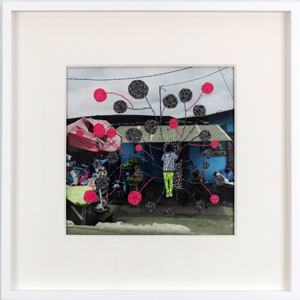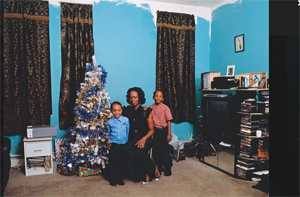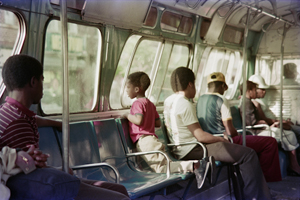A Refuge Among Others
John Haberin New York City
Joana Choumali, Deana Lawson, and Jamel Shabazz
Joana Choumali rises at dawn, but not for a moment to herself alone. Wherever her camera goes, she finds others who love the early light and how it seems to suspend time. Like Deana Lawson, her reach extends to Africa, but always in search of home—its rituals and its refuge in the everyday.
Lawson, too, has come a long way. She has been to Haiti, where she might have seen a voodoo ritual or the pre-Lenten festival of J'ouvert. She has been to New Orleans and Brazil, where the carnival still puts on quite a show. She has been to Ethiopia, which historians from Josephus in Roman times to racist white America have traced back to a curse on the youngest son of Noah, and she photographs a father and child as Sons of Cush. She has been to the Congo, where her Mama Goma shows off her belly through a shimmering blue dress. Yet she never left the lives of African Americans behind. 
She knows that can always return to Brooklyn. So can Jamel Shabazz, and they claim for African Americans what others might fear or despise. Maybe 1980 was not such a bad year after all. New York was filthy and crime ridden, for those who had something to lose. Graffiti covered the subways, and a deadly disease was on its way. Yet a twenty-year-old was back in town, after a stint in the army, and delighted to pick up where he left off.
Shabazz had discovered photography as a teenager in Brooklyn, and he made friends easily, in communities across the city. He took his camera everywhere, from his home borough to the Grand Concourse, which the Bronx Museum still calls home. He had changed his name to insist on his African American identity, and he found a special affinity with those who rode the buses and, from the posters and memories they cherished, called the struggle for rights their own. Even more, he related instantly to signs of pleasure and pride. He had enough of both to go around, even when they stand in the way of art. Now his interests come together, with what the museum calls "Eyes on the Street."
The crack of dawn
Art today is giving proper attention to diversity, but does that mean an art of personal identity or a world of others? Joana Choumali never has to decide, no more than "New Photography 2023" in Lagos. Sometimes she sees a lone woman calling it a refuge much like her. Elsewhere she sees strangers and lovers sharing a moment in a strange but beloved landscape. She is not alone, too, because in her eyes "dawn releases energy"—or Alba'hian in the language of Côte d'Ivoire, or Ivory Coast. It is the title of her latest work.
The series shares the space with earlier work for which the photographer, now in her late forties, is better known, if not yet in New York. (The gallery departs for once from Bruce Nauman, Richard Tuttle, Norman Foster, and an aging agenda.) It, too, is about the search for refuge—not in a moment in time, but in a place. A native of Abidjan, the country's former capital, she turned to a coastal community for the mix of city, landscape, and light. Terrorism had broken its serenity. Still, the series title insists, "Ça Va Aller," or all will be well.
You may have your doubts, but surely so does she. One can hear the desperation in the title and see it beneath the clarity and the joy. Choumali does not depict current events, only day-to-day disturbances. Welcoming waters cannot eliminate cookie-cutter houses and an industrial landscape on the horizon. Men sit side by side along a pier, maintaining what refuge they can by not acknowledging one another. They are going nowhere fast, and that may not be a good thing.
Dawn, too, cuts both ways, in its clear air but shortened sleep and early chill. The iciness, in turn, has its cold but real comforts. In the first series, the soft blue of the distant city contributes almost as much as the deep reds of a changing sky. In the second, Choumali opens a crack in the harsh crack of dawn. She prints on cotton, for a shallower focus, warmer colors, and a painterly texture. One may wonder what here is photography or painting.
Oh, and collage. Works add gilding and other touches, with thin wavering lines in relief. It can take on a life of its own, too, in flora and more tangled growth. It may not spring to life all on its own. A man with a raised arm could be calling up the magic. It also brings Choumali closer to the patterning of folk art, like that of Frédéric Bruly Bouabré, also from Abidjan, in retrospective at MoMA now.
There ought to be a term like "doctored painting" to describe it, by analogy to doctored photographs. So what if these really are photos? They can be sentimental, but still with a basis in observation and magic—and a fresh take on the ancient art of Africa and contemporary African art. People must still navigate a desolate landscape, long shadows, and a gilded net set out to capture birds or them. They may still be rewarded, in turn, with colored balloons and flowers. They may also leave one asking, rightly so, just how much art can offer a refuge.
Everyday rituals
Deana Lawson is proud of her travels, and so are the curators at MoMA PS1, Peter Eleey and Eva Respini with Anni Pullagura. I wonder, though. Wherever she goes, she finds much the same the same determination to dress up and to show off.  They share an urge to expose their flesh and their attachments. They might almost share a single domestic interior of overstuffed sofas and curtained windows, gathering the light while keeping out prying eyes. When I associate an image with a location, I almost certainly give it the lie.
They share an urge to expose their flesh and their attachments. They might almost share a single domestic interior of overstuffed sofas and curtained windows, gathering the light while keeping out prying eyes. When I associate an image with a location, I almost certainly give it the lie.
When she does get closer to places and events, she is more than likely to shift to assemblage and found images. A video collage is an entire compilation of black America, like photography in Harlem for Consuelo Kanaga, its politics and its people, little of it her own. Niagara Falls is all but indistinguishable from Funereal Wallpaper depicting the sea. Right on the way in, one encounters a woman with outrageous jewelry and shining skin. She might be just another example of clichéd temptations and questionable taste, but she is an ad for hair products. Lawson might still be responsible for white flakes on the photo's black surface, out of a disco or a snowfall, that set it apart.
Nearby a woman rolls on the floor in colorful lighting, but this is a 2 Live Crew act, a rephotographed image, and the grain gives it away. An ongoing project collects drug-store photos, while a past project worked within the constraints on visitors to the Mohawk Correctional Facility in Rome, New York. Walker Evans, Ray Johnson, and Jared Bark turned similarly to a photo booth for their visions of America, but Lawson is tracking human and family relations. She is first and foremost a portrait photographer among friends, like Shabazz these same months. One might not know it when a young man poses on a bright white car roof or Uncle Mack with a gun. It is implicit in their possessions all the same.
Lawson, who appeared before at MoMA PS1 in "Greater New York" and in "The Brand New Heavies," speaks of aiming for a "mirror of everyday life," but be sure to preserve the quotes around "everyday." This is the everyday in the sense of life's rituals, from birth to death. Boys do not dress up in church robes every day, and golden seagulls do not fly through every kitchen. An artificial Christmas tree is of a piece with the silver balloon at a woman's wake. Still, Christmas is a family occasion, for a mother and two smiling kids, and the dead woman's husband sits with her as if waiting for her to get out of bed. A family's rituals include whatever it takes to get through the day. That may mean a torn leather sofa, faded wallpaper, and DVDs.
Every so often, a photo quotes art history—but to take that, too, down to the level of the everyday. A nude has an awkward turn and buttocks out of J. A. D Ingres, translating the luxuriant draperies of his Grande Odalisque into the floral patterns of a bare mattress. One might recognize the rocks stretching halfway across the funereal seascape from Claude Monet. But then, whatever the weight of the past, how people live weighs them down that much more. Altar amasses African carvings, an American flag, and whatever else one might choose to worship. A "diva" at age seventy-three sinks into a claustrophobic setting of a chandelier, a piano, modern art, and stuffed toys modeled after a minstrel show.
Things can get awfully garish, like pink glass behind snapshots in an exhibition corner or a gilded boom box set into a museum wall. Things get steamy, too, like a couple chest to chest just a few feet from their baby in a high chair. Lawson has much in common with portraits of black pride in Kehinde Wiley and Mickalene Thomas, and the like, but without their glib acceptance. The inset hologram of a working man comes as criticism of a young man showing off his bling. More often, too, she finds hope in the sadness of the everyday. In her Garden of Eden, humankind has already fallen, to judge by Adam's tender hand on Eve's belly, and a good thing, too.
Whose streets?
Exhibitions keep returning to 1980s for its excitement and its traumas. They have revisited East Village art, back when Soho's commercial scene seemed on its way out, and the AIDS crisis, when no one could know who would live to find out. The Bronx Museum itself has looked back at Alvin Baltrop on the Hudson River piers, then a gay pick-up spot. It has looked, too, to Martin Wong for the face of steel gates, prisons, and sexually attractive men. Still, exciting or despairing, the city was affordable, and an African American could call it home. As for graffiti, Jamel Shabazz tried his hand at that, too, but an art form that meant reaching out was more his style.
You can find your own starting point in forty years of New York, like William Klein before him. It might come in black and white, with men at ease together at a subway entrance to the IRT and BMT. It might come in color, as the city cleaned up its act.  Kids gather after school as aspiring musicians or simply friends. They pose for publicity shots that may never earn publicity but still earned them a good time. For all the clichés, their photo took collaboration and communion.
Kids gather after school as aspiring musicians or simply friends. They pose for publicity shots that may never earn publicity but still earned them a good time. For all the clichés, their photo took collaboration and communion.
Shabazz is never all that original, no more than New York in photocollage for Mary Lum or Sandi Haber Fifield. His is not an art of shocks, surprises, and the brutal frankness of a challenging city. He turned to color photography less for its expressive possibilities than for its brightness. The museum stresses his place in street photography alongside Gordon Parks, Garry Winogrand, and Lee Friedlander. Still, those photographers have a way of making friends into strangers and creepy strangers into the norm. Shabazz, in contrast, evokes lives that you would be proud to know.
He is proud to know them as well, and his skill lies in sharing his pride. He has a talent for setting people at ease—and for getting them to show off in any way they want or can. They are proud themselves, like the dapper black man beside a shop window with tailored suits. Like him, they thrive on company, artificial or real. Brothers and sisters adopt matching profiles. Parade marchers need not stand behind picture frames, as for Lorraine O'Grady, to stand out.
Portraits break the mold, up to a point. They have a second life in broken promises. A boy poses before a storefront, gated and to rent. Even alone, though, they have found company or fashioned it. A girl brings a rose to the beach and plants it in the sand. A man gains control of his dog, right in the middle of the street, but they are well matched.
Shabazz had a day job—in the psychiatric hospitals of Wards Island and then as a counselor on Rikers Island, the notorious jail complex. There, too, he brought connections to others most in need, and his sympathy extended to fellow employees as well. Back on the streets, police in photos look as good as anyone, black or white. Shabazz can be painfully close to such fashionable painters as Kehinde Wiley today, smoothing over the rough edges. He comes closer still to James Van Der Zee, the quasi-official photographer of the Harlem Renaissance. Yet he uses street photography to ask who owns the streets.

Joana Choumali ran at Sperone Westwater through April 30, 2022, Deana Lawson at MoMA PS1 through September 5, and Jamel Shabazz at the Bronx Museum through September 4.




